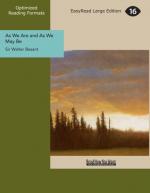Let us, however, consider. First, there is the hopeful fact that the Sunday-School Union numbers 12,000 teachers—all voluntary and unpaid—in London alone. There is, next, another hopeful fact in the rapid development of the Home Arts Association, which has existed for no more than a year or two. The teaching is wholly voluntary; and volunteers are crowding in faster than the slender means of the Society can provide schools for them to teach in, and the machinery, materials, and tools to teach with. Even with these facts before us, the projector and dreamer of the scheme may appear a bold man when he asks for 2,400 men and women to help him, not in a religious but a purely secular scheme. Yet it may not appear to many people purely secular when they remember that he asks for this large army of unselfish men and women—so unselfish as to give some of their time, thought, and activity for nothing, not even praise, but only out of love for the children—from a population of four millions, all of whom have been taught, and most believe, that self-sacrifice is the most divine thing that man can offer. To suppose that one in every two thousand is willing to the extent of an hour or two every week to follow at a distance the example of his acknowledged Master does not, after all, seem so very extravagant, For my own part, I believe that for every post there will be a dozen volunteers. Is that extravagant? It means no more than a poor 1 per cent, of such distant followers.
Those who go at all among the poor, and try to find out for themselves something of what goes on beneath the surface, presently become aware of a most remarkable movement, whispers of which from time to time reach the upper strata. All over London—no doubt over other great towns as well, but I know no other great town—there are at this day living, for the most part in obscurity, unpaid, and in some cases alone, men and women of the gentle class, among the poor, working for them, thinking for them, and even in some cases thinking with them. One such case I know where a gentlewoman has spent the greater part of her life among the industrial poor of the East End, so that she has come to think as they think, to look on things from their point of view, though not to talk as they talk. Some of these men are vicars, curates, Nonconformist ministers, Roman Catholic clergymen; some of the women are Roman Catholic sisters and nuns; others are sham nuns, Anglicans, who seem to find that an ugly dress keeps them more steadily to their work; others are deaconesses or Bible-women. Some, again, and it is to these that one turns with the greatest hope—they may or may not be actuated by religious motives—are bound by no vows, nor tied to any church. When twenty years ago Edward Denison went to live in Philpot Lane, he was quite alone in his voluntary work. He had no companion to try that experiment with him. Now he would be one of many. At Toynbee Hall are gathered together a company of young and generous




